Inpatient census 2017: parts one and two
Results of the third Mental Health & Learning Disability Inpatient Bed Census and Out of Scotland NHS Placements Census, 2017.
This document is part of a collection
4. Additional Analysis: Patients receiving Forensic Services
- 484 patients in the census were receiving Forensic Services, 14% of all Census patients
- Patients receiving Forensic Services are mostly males of working age
- 78% of forensic patients were either Overweight or Obese as at the Census
Forensic psychiatry is a specialised branch of clinical psychiatry which relates to mentally disordered offenders and others with similar problems. For the purpose of the analysis contained in this section, forensic patients were identified if NHS Boards indicated ‘yes’ to the following Census question: is the patient being managed primarily by forensic services?
There were 484 patients primarily managed by Forensic Services in the 2017 Census. This is an increase on the 458 patients reported in 2016.
It should be noted that NHS Greater Glasgow & Clyde, NHS Lothian and NHS Tayside contain Forensic Regional Units which provide services to patients from other NHS Boards. NHS Fife also provide a low secure Learning Disability (Forensic) Regional Unit for the treatment of patients from other NHS boards. The State Hospital (a Special NHS Board), provides a National Service (including for Northern Ireland).
Table 9: Number of patients (forensic services) by NHS Board in each Census
| Number of Patients |
|||
|---|---|---|---|
| NHS Board of Treatment |
October 2014 |
March 2016 |
March 2017 |
| NHS Ayrshire & Arran |
* |
* |
16 |
| NHS Borders |
0 |
* |
0 |
| NHS Dumfries & Galloway |
0 |
* |
0 |
| NHS Fife |
31 |
34 |
39 |
| NHS Forth Valley |
20 |
* |
* |
| NHS Grampian |
42 |
42 |
40 |
| NHS Greater Glasgow & Clyde |
128 |
122 |
119 |
| NHS Highland |
* |
* |
* |
| NHS Lanarkshire |
19 |
15 |
20 |
| NHS Lothian |
65 |
47 |
56 |
| NHS Tayside |
65 |
55 |
64 |
| NHS Western Isles |
0 |
0 |
0 |
| State Hospital |
121 |
117 |
111 |
| Scotland |
507 |
458 |
484 |
* Suppressed due to small numbers
Age and Gender
Figure 21 shows the majority of patients receiving forensic services are working age males. Male patients made up 94% of all forensic services patients in the 2017 Census, the same as the 2016 Census. Of the females in forensic services, 100% were aged between 18 – 64.
Figure 21: Number of patients (forensic services), age and gender, March 2017 Census
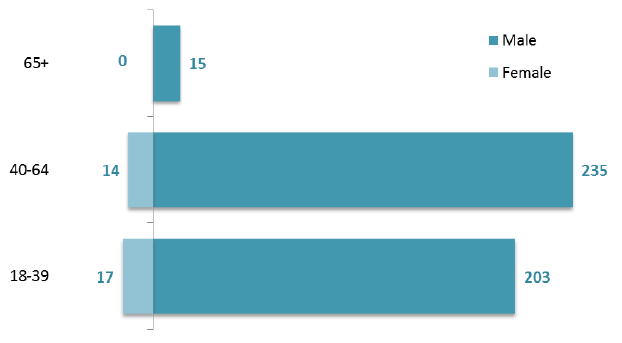
Ward Type
Most patients receiving forensic services were treated in a forensic ward; 414 (86%) patients. Of these, 70 were in a learning disability ward. A further 18 (4%) of patients were in an intensive psychiatric care unit. See figure 22 for more details.
Figure 22: Number of patients (forensic services), by ward type, March 2017 Census
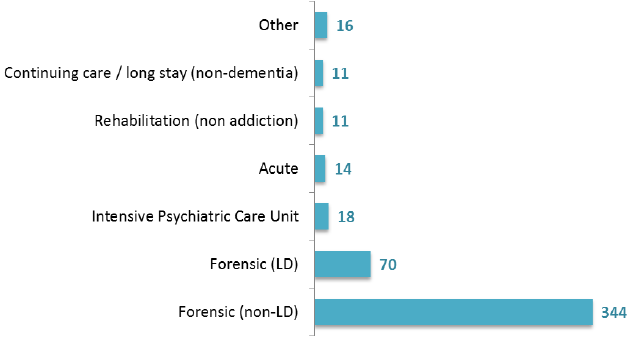
Ward Security Level
There were 164 (34%) patients receiving forensic services in a low security ward in the 2017 Census. A further 131 (27%) were in a medium security ward, while 111 (23%) were in a high security ward. Only 6% were in a general psychiatric ward, compared with 76% of all mental health, addiction or learning disability patients. See figure 23 for more details.
Figure 23: Number of patients (forensic services), by ward security level, March 2017 Census
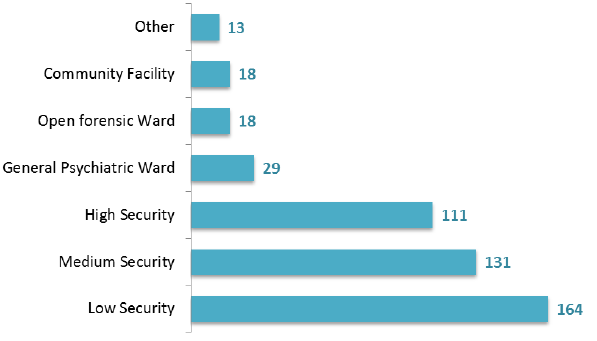
Specialty of Consultant
A total of 447 patients receiving forensic services were seen by a forensic psychiatrist. This is 93% of forensic services patients for whom this information was returned. There were 17 (4%) patients being seen by a consultant whose specialty was learning disabilities. See figure 24 below for more details.
Figure 24: Number of patients (forensic services), by consultant specialty, March 2017 Census
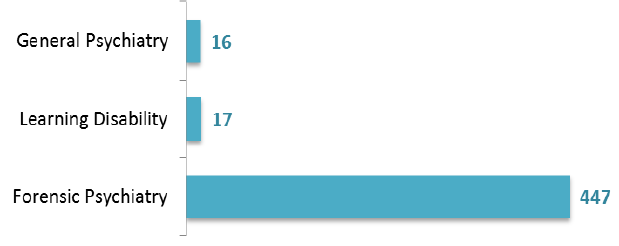
Length of stay in hospital
Of the 484 patients receiving forensic services in the 2017 Census, 328 (68%) had been in hospital for over a year. Only 13 (3%) of patients had been in hospital for less than two weeks. See table 10 for more details.
Table 10: Number of days since admission (forensic services), by Census
| Days since admission |
Patients (March 2016) |
Patients (March 2017) |
||
|---|---|---|---|---|
| Less than 2 weeks |
10 |
2% |
13 |
3% |
| At least 2 weeks, less than 1 month |
10 |
2% |
15 |
3% |
| At least 1 month, less than 3 months |
23 |
5% |
36 |
7% |
| At least 3 months, less than 6 months |
49 |
11% |
34 |
7% |
| At least 6 months, less than 1 year |
45 |
10% |
58 |
12% |
| At least 1 year, less than 5 years |
202 |
44% |
203 |
42% |
| 5 years or more |
119 |
26% |
125 |
26% |
The average (median) time since admission at the 2017 Census for patients receiving forensic services was just over two years. This compares with non-forensic services patients who had an average (median) admission time of around four months, see table 11. The higher length of stay for forensic services patients will be influenced by the high number of medium and high security ward patients.
Table 11: Average number of days since admission (forensic V non-forensic), March 2017
| Group |
Average (median) number of days since admission |
Approx. number of years / months |
|---|---|---|
| Forensic Services Patients |
789 |
2 years, 2 months |
| Non-forensic Services Patients |
114 |
4 months |
Forensic patients on pass
At the 2017 Census, 20 (4%) patients receiving forensic services were on pass. Of these patients, 14 (70%) were at home.
Observation level
All patients in mental health inpatient settings will receive some degree of observation. However, levels of observation will vary according to the patients’ individual needs. Based on current guidelines the level of observation of patients at the time of the Census was recorded. The observation levels are:
- “General Observation” – Staff should have a knowledge of the patients’ general whereabouts.
- “Constant Observation” – Staff should be constantly aware of the precise whereabouts of the patient.
- “Special Observation” – Patient should be in sight and within arm’s reach of a member of staff.
- Enhanced care plan for therapeutic engagement - Aims to improve observation practice through therapeutic engagement with suicidal, violent or vulnerable patients to prevent them from harming themselves or others at times of high risk during their recovery.
Most patients receiving Forensic Services (93%) fall under the General Observation category, while 21 (4%) were under constant observation. See figure 25.
Figure 25: Number of patients (forensic services), by observation level, March 2017 Census
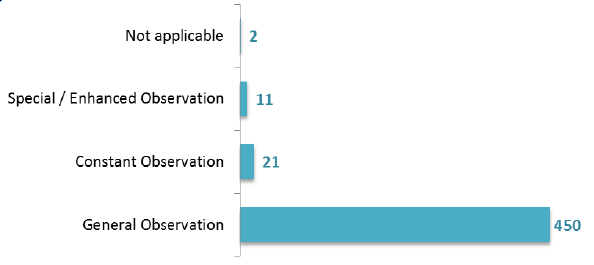
* Not applicable may relate to patients being treated in care homes where an observation level may not apply, or patients on pass
Health and Wellbeing
The following sections consider the mental and physical health of patients receiving forensic services at the 2017 Census.
Mental health morbidities
NHS Boards were asked to return diagnosis codes ( ICD 10) for any mental health condition for which patients in the 2017 Census had a diagnosis. Of the 476 patients receiving forensic services for which diagnosis information was returned, 158 (33%) had 2 or more mental health conditions, this compares to 20% for all adult patients.
Figure 26: Number of patients (forensic services), by number of mental health conditions, March 2017
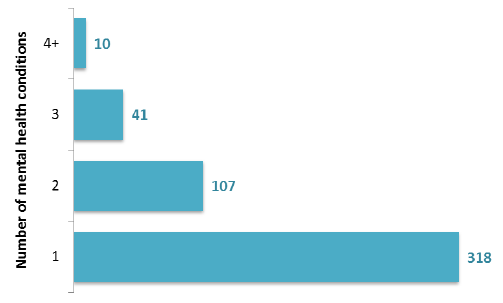
The most common condition for patients receiving forensic services is schizophrenia; a total of 308 (65%) patients for which a mental health diagnosis was known, had this condition. The second most prevalent condition was Personality Disorder, with 26% of forensic services patients for which a mental health diagnosis was known, had this diagnosis. See figure 27 for more details.
Figure 27: Number of patients (forensic services), by selected mental health condition, March 2017
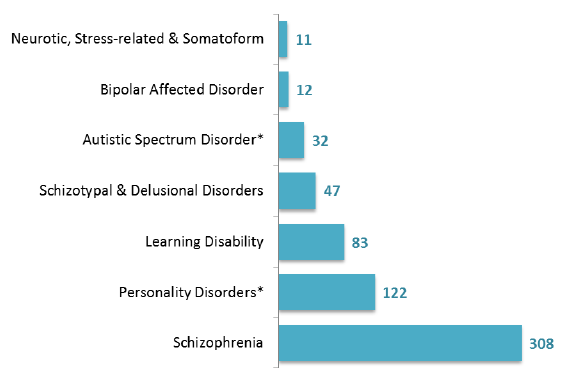
* All mental health diagnoses are based on ICD 10 codes. Primary and secondary diagnoses included
* Personality Disorders and Autistic Spectrum Disorder counts also rely on respective questions on these disorders
* Patients may have more than one diagnosis
Physical health co-morbidities
The Mental Health Strategy 2017 – 2027 emphasised the importance of considering physical health along with mental health and how the outcomes of both are linked. A key outcome from the 2014 Census was the need to improve the recording of both mental health and physical health morbidities. Mental Health and Learning Disability services in NHS Boards are working towards routinely recording physical health conditions under the International Classification of Diseases. The 2016 Census included a suite of Yes/No physical health questions and these were retained for the 2017 Census.
List of yes/no physical health morbidities questions in the Census:
● Hypertension,
● Dyslipidaemia,
● Coronary heart Disease,
● Epilepsy,
● Chronic Kidney Disease,
● Thyroid Disease,
● Cancer,
● Alcohol Acquired Brain Injury,
● Diabetes,
● Chronic Obstructive Pulmonary Disease,
● Chronic Pain,
● Sensory Impairment,
● Liver Disease,
● Acquired Brain Injury,
● Stroke / Transient Ischaemic Attack,
● Parkinson
A total of 218 (45%) patients receiving forensic services had at least one physical health co-morbidity based on the suite of Yes/No physical health questions as at the 2017 Census. This is higher than the 41% of patients reported in 2016. The figure is lower than the 58% for all adult patients, though forensic patients tend to be younger so this would be expected. See figure 28 for more details.
Figure 28: Number of patients (forensic services), by number of physical conditions (based on suite of Yes/No questions), March 2017
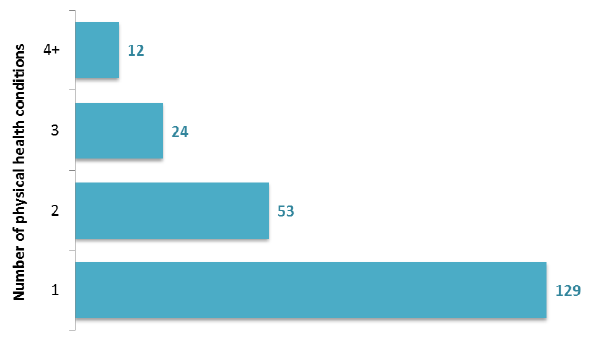
Figure 29 shows a breakdown of the number of patients receiving forensic services for selected physical conditions. The most common condition was dyslipidaemia; a total of 70 (14%) patients receiving forensic services had this condition. The second most prevalent was diabetes, with 13% of patients having this condition.
Figure 29: Number of patients (forensic services), by selected physical conditions, March 2017
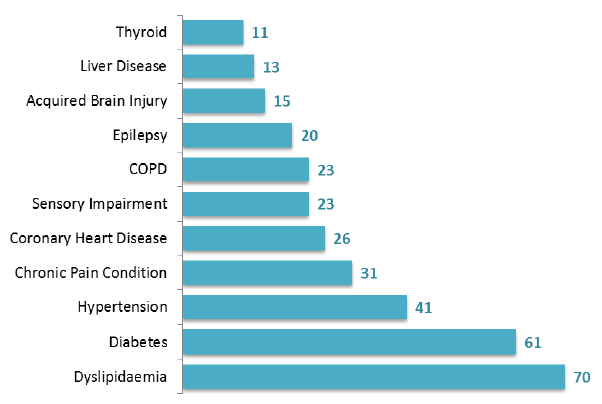
* Patients may have more than one condition
Physical Health Check
The 2017 Census included for the first time questions related to physical health checks. These follow on from actions on mental health set out by the Chief Medical Officer ( http://www.sehd.scot.nhs.uk/cmo/CMO(2015)19.PDF). There were two questions;
- For patients admitted to a mental health bed between the 1 st April 2016 and 30 th March 2017: Did the patient receive a general physical examination by a qualified clinician within a day of admission?
- For patients admitted to a mental health bed prior to the 1 st April 2016: Has the patient had an annual (physical) check within the last year? An annual health check should be both a physical assessment and delivery of health promotion activity.
There were 155 patients receiving forensic services who were admitted between 1 st April 2016 and the 30 th March 2017. Of these, 122 (79%) had a general physical examination within a day of admission. This is lower than the 89% for all adult patients, however more forensic patients declined an assessment. A total of 12 (8%) patients were not offered a general physical examination, higher than the 4% for all adult patients.
There were 329 patients receiving forensic services who were admitted prior to the 1 st April 2016. Of these, 275 (84%) had received a physical health check within the last year. This is 2% higher than for all adult patients. A further 23 (7%) were offered but declined, again, higher than the 4% for all adult patients. A total of 15 (5%) patients were not offered an annual physical health check.
Overall in the 2017 Census, a total of 397 (82%) of patients received some form of physical health check, lower than the 87% for all patients.
Lifestyle factors
BMI (Body Mass Index)
BMI (Body Mass Index) was calculated for patients whom height and weight information was returned. Additional patients were excluded because height and weight were extreme outliers (<10 forensic patients). Of those patients included, a total of 225 (47%) patients receiving forensic services were obese, while 149 (31%) were overweight. The 78% of forensic patients overweight or obese is higher than the 58% reported for all adult patients.
Smoking, alcohol and other substance misuse
This section contains analysis of patients with alcohol dependence and / or substance misuse based on responses for a combination of questions. A minor methodological change was made in 2017 (see Section 6 for further detail).
A total of 170 (35%) forensic patients smoked tobacco in the 12 weeks prior to the Census date. This is similar to the 33% for all adult patients and is up slightly on the 33% in 2016.
In the 2017 Census, 148 (31%) of forensic patients had a dependence on alcohol / harmfully used alcohol, of which 12% had an alcohol related ICD 10 code. The proportion with a dependence on alcohol / harmfully used alcohol are similar to 2016 and continue to be much higher than for all patients (19%).
A total of 206 (43%) of forensic patients had abused substances (excluding alcohol) in the 2017 Census. Of these, 58 (28%) had a related ICD 10 code. The proportion who had abused substances (excluding alcohol) was similar to 2016 and continued to be much higher than for all patients (17%).
Figure 30: Number of patients (forensic services), smoking, drugs and alcohol, March 2017
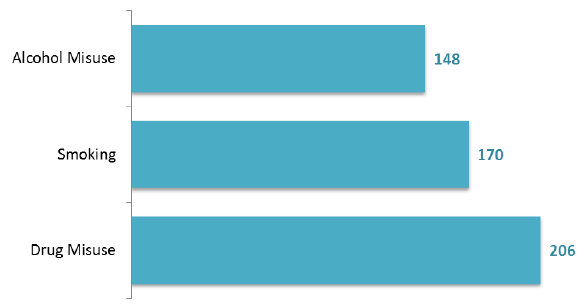
Self-harm
Information on self-harm was returned for 356 (74%) of forensic patients. Of these, 52 (15%) had self-harmed in the week prior to admission. This is higher than the 11% reported for all adult patients, although it is lower than the 17% repored in 2016.
For those 52 patients, 36 (69%) had self-harmed by non-accidental injury.
Suicidal ideation
Information on suicidal ideation was returned for 355 (73%) of forensic patients. Of these, 14 (4%) had expressed suicial ideation on admission to hospital. This is lower than the 7% reported in 2016 and lower than the 12% reported for all adult patients.
Contact
Email: Guy McGivern, SWStat@gov.scot
Phone: 0300 244 4000 – Central Enquiry Unit
The Scottish Government
St Andrew's House
Regent Road
Edinburgh
EH1 3DG
There is a problem
Thanks for your feedback